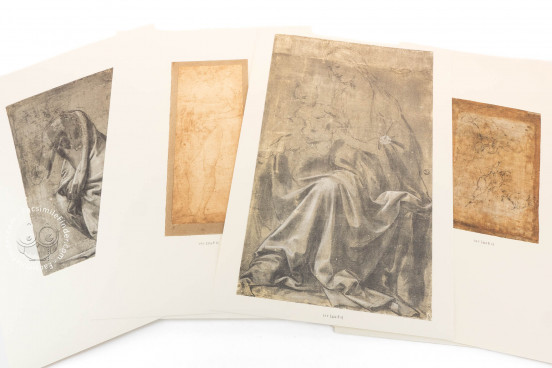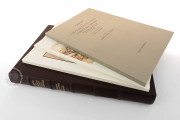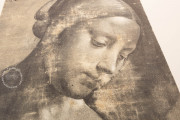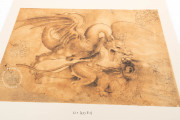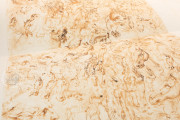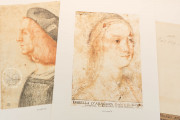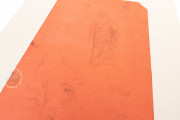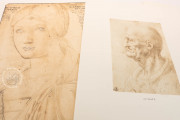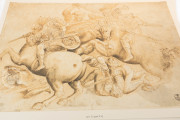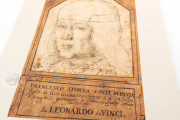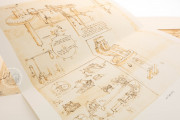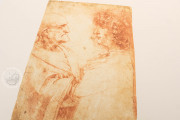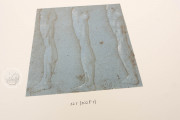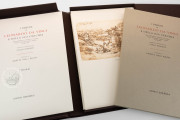The Drawings by Leonardo da Vinci and His Circle in the Uffizi is a collection of fifty plates, eleven of which have been attributed to Leonardo. Among these is Leonardo's earliest known drawing, the first drawing in Western art to have as its subject pure landscape. It is the famous view of the Arno River valley seen from the slopes of Mount Montalbano, signed and dated 5 d’agosto 1473 (August 5, 1473).
The drawings of Leonardo's followers are equally important, not only for what they might reflect of Leonardo's teachings, but also because they often preserve traces of his own involvement.
Uzielli's Contribution to Cataloging Leonardo's Work
In 1884, Gustavo Uzielli offered the catalogs of three collections of drawings by Leonardo and his school - those of the Uffizi Gallery, the Royal Library of Turin, and the Academy of Venice, also making use of partial catalogs previously published or manuscript catalogs preserved at the individual institutions. In another part of his work, in expressing his opinions on the best way to publish Leonardo's works, Uzielli proposed publishing the Vinci materials in groups according to the collections that preserved them.
The Uffizi Collection
The Uffizi collection, which in Uzielli's list counts thirty-nine numbers, had a different fate from that of the other funds. The so-called "official" publication, edited by Giovanni Poggi and appearing in 1920 in the series of Drawings of the R. Galleria degli Uffizi in Florence by the publisher Olschki, consists of only five drawings by Leonardo, occupying the last plates 16-20, while the first fifteen plates reproduce the Adoration of the Magi and related details, with the justification that this work is to be considered among the most precious drawings of Leonardo because it is as is known unfinished, with only very slight traces of color.
In the case of the Uffizi collection, a publication that limited itself to presenting the drawings of Leonardo and his school could have been exhausted in a selection of twenty plates. Here instead, there are fifty, ensuring scholars the possibility of also receiving those drawings no longer assigned to the Leonardesque sphere but cited in old publications for their supposed relationship with Leonardo or aspects of his teaching. The advantage of this type of inventory or survey lies in the possibility of deepening, on a critical level, the knowledge of the complex story of Leonardo's influence on contemporaries and successors.
Gigetta Dalli Regoli's Cataloging Effort
The cataloging of the group of Uffizi drawings, which are predominantly Tuscan, was entrusted to Gigetta Dalli Regoli. Apart from her contribution to the study of autograph drawings, especially in the complex aspects of Leonardo's formative phase (and ten of the eleven autograph drawings are assignable to the time before Leonardo's transfer to Milan in 1482), it is precisely the problematic developments of Florentine art at the beginning of the 16th century that are marvelously brought into focus through the examination of drawings reflecting Leonardo's presence in his homeland upon his return from Lombardy.
Cardinal Leopoldo de' Medici's Role in Assembling the Uffizi Collection
The main core of the drawings of Leonardo and his school at the Uffizi is part of a collection of relatively recent origin as it was desired by Cardinal Leopoldo de' Medici (1617-1675), the last of the children of Grand Duke Cosimo II and Maria Maddalena of Austria, sister of Emperor Ferdinand II. The task of coordinating the work of research, purchase, and arrangement of the materials was entrusted to him by the historian Filippo Baldinucci, who, starting his work before 1665, diligently and successfully devoted himself to it for over ten years.
The Landscape of 1473: A Promising Beginning
Among the jewels of the collection, the Landscape of 1473 stands out, considered the oldest drawing by Leonardo. This work, created when Leonardo was only 21 years old, already shows his unparalleled ability to capture nature with precision and sensitivity. This landscape is not only an artistic masterpiece but also marks the beginning of his deep commitment to the study of nature, a constant that permeates his entire career.
The Head of a Young Woman: An Example of Beauty and Technique
Another notable piece in the collection is the drawing of the Head of a Young Woman. This work is a sublime example of Leonardo's ability to capture human grace and beauty. The drawing shows a refined shading technique and a delicate play of light and shadow, elements that characterize many of his most famous works.
Leonardo's Anatomical Studies: Merging Art with Science
Among the treasures of the collection are Leonardo's anatomical studies, demonstrating his scientific approach and his effort to understand the human body in a precise and detailed way. These studies represent a turning point in the representation of the human body in art.
We have 1 facsimile edition of the manuscript "Drawings by Leonardo da Vinci and His Circle - Galleria degli Uffizi (Collection)": Disegni di Leonardo da Vinci e della Sua Cerchia - Galleria degli Uffizi, Firenze facsimile edition, published by Giunti Editore, 1985
Request Info / Price
